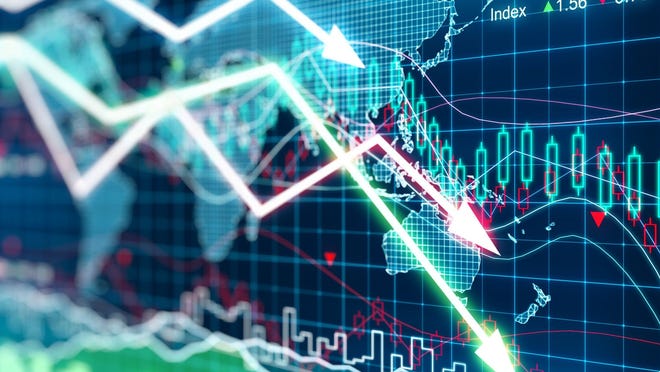
Wall Street’s coronavirus panic means little for Americans without wealth to invest
Editor’s note: Voices for Human Needs contributor Andrew L. Yarrow is a former New York Times reporter and history professor who writes frequently on the socioeconomic difficulties of struggling Americans, including in his recent book, “Man Out: Men on the Sidelines of American Life.” Follow him on Twitter: @ALYarrow. This op-ed originally appeared in USA TODAY and is cross-posted with permission.
Monday’s 1,031-point stock market plunge certainly brought panic to financiers, traders, policymakers and investors. But did the long stock market rise parallel the fortunes of America’s real economy?
 The Dow Jones Industrial Average skyrocketed by more than 20,000 points since its low in March 2009, enriching big investors and enabling President Donald Trump to claim that “our economy is the best it has ever been.” Someone who invested $10 million in an index fund in 2009 would now have more than $50 million. Not bad. Unfortunately, what’s happening on Wall Street has little or no day-to-day relevance to most Americans.
The Dow Jones Industrial Average skyrocketed by more than 20,000 points since its low in March 2009, enriching big investors and enabling President Donald Trump to claim that “our economy is the best it has ever been.” Someone who invested $10 million in an index fund in 2009 would now have more than $50 million. Not bad. Unfortunately, what’s happening on Wall Street has little or no day-to-day relevance to most Americans.
“Journalists are obsessed with the stock market,” says Jacob Hacker, director of the Institution for Social and Policy Studies at Yale University. “But for most Americans, it’s a side show in their economic lives. What really matters to them is the security of their jobs and health care, and the amount they have to pay for big-ticket items like housing and education.”
Real wages for the typical American worker have risen by a mere 5% during the past decade and, in fact, are only about 11% higher than they were in 1979, according to the Federal Reserve Bank of St. Louis.
More than 2 out of 5 American workers are in low-wage jobs, defined as less than two-thirds of the median wage. They toil in restaurants, as health aides and janitors. The people who clean sports stadiums make about $14 per hour, picking up trash from sports fans who may pay hundreds of dollars to sit on the 50-yard line.
Most low-wage workers are women and people of color, although there are many white male workers who have low-paying jobs. Of the 11 million single parents in the United States, 8.5 million are single mothers. And nearly 30% of those mothers live in poverty. Most do not have college educations and could not afford one even if they wanted a four-year degree.
Nearly half of all workers do not have a retirement savings plan and, for many, employer-provided health insurance comes with ever higher deductibles and co-pays.
Of course, for the half of working Americans with a 401(k) account, today’s stock market decline does mean a loss. But the real problem is the inability of many workers to save, as the median 401(k) balance is just $36,000 for 40- to 49-year-olds with these retirement plans.
Tens of millions of low-income Americans have more than their share of strikes against them: They were formerly incarcerated. They are substance abusers. Millions are jobless, have given up looking for jobs and are out of the workforce, not counted in official unemployment statistics. Millions of working young adults live with their parents because they can’t afford to rent a small apartment.
The Wuhan coronavirus and its impact on the Chinese economy — and potential impact on the global economy — are cited as the major reasons for Monday’s stock market sell-off. However, it is poor, low-wage and even many middle-class Americans who are more likely to be in poor health and have a significantly shorter life expectancy than those who have higher incomes and are well educated. The richest American men live 15 years longer than the poorest.
A huge collapse in the stock market makes little difference to them. How could it, if one is behind on one’s bills, has a broken-down car, needs food stamps to eat and Medicaid to get health care.
Conversely, a 1,000-point drop in the Dow Jones is not going to stop the wealthiest Americans from buying homes around the world and a yacht or private jet where they can drink Dom Perignon. As inequality has grown, the top one-fifth of earners account for about 55% on the nation’s annual income. By comparison, the bottom 20% account for just 4% of all income.
Since investments in equities represent wealth, the wealth comparisons are even more glaring. The top 1% hold nearly 40% of the country’s wealth, significantly more than the middle 60% of the income distribution. If those at the top bewail the millions in stock-market investments wiped out Monday, remember: 2 out of 5 households do not have enough savings to make ends meet for three months at the poverty level if they had no income.
Let’s make the distinction: Today was an awful day for investors, but too many Americans don’t have the savings to participate in the stock market at all. For them, today’s trillion dollar economic calamity means little.
Andrew L. Yarrow is a former New York Times reporter and history professor who writes frequently on the socioeconomic difficulties of struggling Americans, including in his recent book, “Man Out: Men on the Sidelines of American Life.” Follow him on Twitter: @ALYarrow

